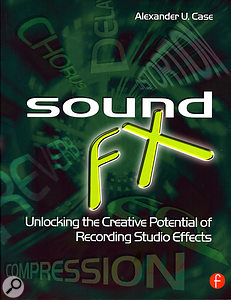Although first published in 2007, I only became aware of this interesting book very recently, when I found it on a recommended-reading list for a music technology course at a UK university. Its full title is Sound FX: Unlocking The Creative Potential Of Recording Studio Effects, it’s published by Focal Press, and the ISBN is 978-0-240-52032-2. The author, Alexander Case, has degrees in Mechanical Engineering, Music, and Acoustics, and is clearly a man on top of the science and engineering aspects of the topic, but this book is much more about the art and technique of using studio effects processors (in the widest sense of that term) than it is about the technology behind them.
Divided into 15 chapters grouped into four sections, the book starts with the usual basics of audio waveforms and decibels, and includes some potentially offputting academic maths equations. Thankfully, this is not indicative of the rest of the book, which is far more practically oriented! The next chapter covers the concepts of signal flow and the ways in which effects processors can be introduced into different systems, and this first section closes with a chapter on perception, listening, and auditory masking, to help the reader understand what he is (and isn’t) hearing.
The second section covers ‘Amplitude FX’, starting with different types of distortion and equalisation before launching into dynamics. The chapters on compression, limiting, expansion, and gating go into the topics in great detail and depth, but all in a very practical and understandable way, often shining light on the subject from refreshing angles — this has to be one of the best treatises on dynamic manipulation techniques that I’ve read anywhere. This section closes with an examination of volume processing effects, such as faders, pan-pots, muting, automation, cross-fades and so on.
Having dealt with amplitude-based effects the book progresses to ‘Time FX’, covering the different kinds of delays and the effects that can be created from them like flanging, phasing, and chorus. It then goes on to examine pitch-shifting effects and, finally, reverberation. Most chapters include a short discography with examples of commercial tracks to illustrate the points being made, and there are more purpose-made examples available on a dedicated supporting web site, too.
Closing the book is a section titled ‘Applied FX’ and, as the name suggests, this discusses a wide variety of practical situations where employing different effects helps to improve mixes. Particular emphasis is given to shaping the snare-drum component of a mix, as well as a rather unexpected focus on pianos. There’s also an entire chapter on automation techniques for mixing.
I thoroughly enjoyed reading this book and found the overall approach very refreshing. It will certainly appeal to all students of audio production, regardless of their level of experience, not least because of the way it encourages the process of identifying a problem or a desired outcome first, before working out how to achieve that goal using effects processors, setting them up from first principles. It provides understandable explanations of how the processes work, and everything is tied to reality with excellent down-to-earth practical advice throughout. Highly recommended.
£29.99.
$48.95.

